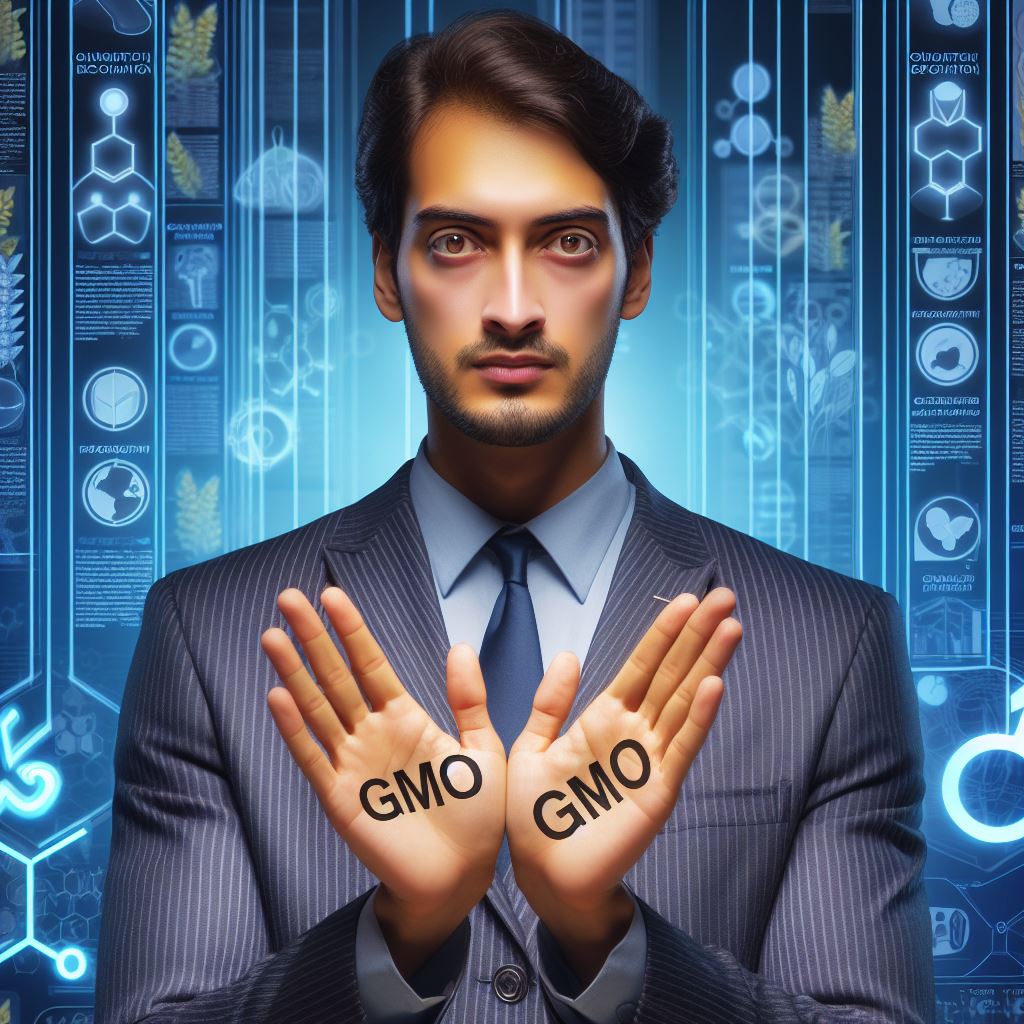Introduction
Let’s explore GMO Regulations’ Current Status.
Definition of GMO (Genetically Modified Organism)
A genetically modified organism (GMO) refers to any living organism that has been altered by genetic engineering techniques.
GMO regulations are crucial to ensure public health and environmental safety.
This blog post aims to discuss the current status of GMO regulations and their significance.
Importance of GMO regulations
Genetically modified organisms have become increasingly prevalent in agriculture and food production.
The regulations surrounding GMOs play a vital role in safeguarding human health, protecting ecosystems, and ensuring consumer confidence.
GMOs are created by inserting genes from one species into another, often to enhance desirable traits such as increased crop yield or resistance to pests.
However, concerns about the potential risks and long-term effects of GMOs have prompted the development of strict regulations.
Purpose of the blog post
The primary purpose of GMO regulations is to assess the safety of genetically modified products before they enter the market.
Regulatory agencies evaluate the potential risks and benefits associated with GMOs through rigorous testing and scientific analysis.
These regulations involve assessing the impact of GMOs on human health, animal welfare, and the environment.
They aim to prevent any adverse effects, such as allergenicity, toxicity, or disruption of ecosystems.
By implementing GMO regulations, governments strive to protect both consumers and the environment from potential harm.
Furthermore, GMO regulations require labeling and traceability of genetically modified products.
This empowers consumers to make informed choices about the products they purchase and consume.
Transform Your Agribusiness
Unlock your farm's potential with expert advice tailored to your needs. Get actionable steps that drive real results.
Get StartedClear labeling helps individuals with specific dietary preferences, religious beliefs, or health concerns to identify and avoid GMO-containing products.
In general, GMO regulations are of utmost importance for ensuring the safety, accountability, and transparency of genetically modified organisms.
These regulations serve to protect human health, maintain ecological balance, and empower consumers with the right to choose.
As GMO technology continues to evolve, ongoing scrutiny and adherence to regulations are crucial for sustainable and responsible use.
Overview of GMO regulations
A brief history of GMO regulation development
- The regulation of GMOs has evolved to address concerns about their safety and impact on the environment.
- In the 1980s, the first GMOs were developed and brought to market, leading to the need for regulations.
- Initially, GMO regulation focused on assessing the safety of these products and determining potential risks.
- As GMO technology progressed, regulators realized the importance of labeling GMO products to provide consumers with information.
- Throughout the 1990s and early 2000s, countries began implementing their own GMO regulations to ensure public safety.
Key organizations involved in regulating GMOs
- The Codex Alimentarius Commission, established by the World Health Organization and the Food and Agriculture Organization, provides international guidelines for GMO regulations.
- The European Union has stringent regulations on GMOs, requiring labeling and risk assessments before approval.
- The United States follows a regulatory framework where GMOs are assessed for safety on a case-by-case basis.
- The World Trade Organization ensures that countries’ GMO regulations do not become trade barriers.
- Other countries, such as Brazil, China, and Japan, have their regulatory agencies overseeing GMOs.
Current status of GMO regulations globally
- GMO regulations vary significantly from country to country, resulting in a complex landscape for farmers, researchers, and consumers.
- The European Union has the strictest regulations, with a lengthy approval process and mandatory labeling of GMO products.
- The United States takes a more lenient approach, focusing on the safety assessment of new GMOs rather than mandatory labeling.
- Several African countries have imposed bans or restrictions on GMO cultivation and importation.
- Asia, particularly China and India, plays a significant role in GMO production, but regulations differ among countries in the region.
- Overall, the majority of countries have implemented some form of GMO regulation, albeit with varying stringency.
GMO regulations continue to be a hotly debated topic, with proponents arguing for strict oversight to ensure safety and protect the environment, while opponents emphasize the potential benefits of GMOs and the need for streamlined regulations to foster innovation.
Read: Organic Vs Conventional: Policy Differences
GMO regulations in the United States
Overview of the regulatory framework
The United States has established a regulatory framework to oversee the production and distribution of genetically modified organisms (GMOs).
This framework is primarily based on the concept of substantial equivalence.
The concept of substantial equivalence assumes that GMOs are safe unless proven otherwise.
However, it does not require specific safety assessments or mandatory labeling for all GMOs.
Under the regulatory framework, GMOs are evaluated by several government agencies before they can be approved for commercial use.
The key agencies involved in GMO regulations are the United States Department of Agriculture (USDA), the Food and Drug Administration (FDA), and the Environmental Protection Agency (EPA).
Key government agencies responsible for overseeing GMO regulations
The United States Department of Agriculture (USDA) is primarily responsible for ensuring the safe production and distribution of genetically modified crops.
The USDA evaluates GMOs to determine their potential environmental impact, assesses their potential weediness and invasiveness, and oversees compliance with relevant regulations.
The Food and Drug Administration (FDA) is responsible for the safety of GMOs in food and animal feed.
It ensures that GMOs do not pose any health risks and that food products are properly labeled.
The Environmental Protection Agency (EPA) regulates GMOs that are designed to produce pesticides.
It evaluates the potential risks and benefits of these GMOs to human health and the environment.
Main GMO labeling requirements and controversies
In the United States, GMO labeling is not mandatory.
However, voluntary labeling is allowed if it meets specific guidelines set by the FDA.
The main controversy surrounding GMO labeling in the United States is the lack of transparency.
Many consumers believe they have a right to know if their food contains GMOs and advocate for mandatory labeling.
Opponents of mandatory labeling argue that it would imply that GMOs are unsafe, despite the scientific consensus that they are safe.
They also argue that mandatory labeling would increase food costs.
Showcase Your Farming Business
Publish your professional farming services profile on our blog for a one-time fee of $200 and reach a dedicated audience of farmers and agribusiness owners.
Publish Your ProfileRecent updates or changes in GMO regulations
In recent years, there have been some updates and changes to GMO regulations in the United States.
One significant change was the passing of the National Bioengineered Food Disclosure Standard in 2016.
This standard requires mandatory disclosure of GMO ingredients through either text or symbols on food packaging.
Another notable change is the proposed updates to GMO regulations by the USDA in 2020.
These updates aim to streamline the regulatory process, provide greater flexibility, and enhance transparency in GMO oversight.
Despite these updates, controversies and debates surrounding GMO regulations continue to shape the future of GMO oversight in the United States.
Read: Agricultural Policy Updates: Impact on Farmers
GMO regulations in Europe
Overview of the regulatory framework
Europe has a comprehensive regulatory framework for genetically modified organisms (GMOs).
The primary legislation governing GMOs in the European Union (EU) is Directive 2001/18/EC.
This directive lays down the procedures for the deliberate release of GMOs into the environment.
It also covers the placing on the market of GMOs as or in products.
Additionally, Regulation (EC) No 1829/2003 regulates the labeling and traceability of GMOs and their products.
Key government agencies responsible for overseeing GMO regulations
In Europe, several agencies are responsible for overseeing GMO regulations.
The European Food Safety Authority (EFSA) plays a crucial role in providing scientific opinions on GMOs.
EFSA assesses the safety of GMOs for human and animal health and the environment.
The European Commission, the executive body of the EU, is responsible for proposing new legislation and implementing regulations.
Member states, through their national competent authorities, also have a role in GMO regulation and enforcement.
EU’s Precautionary Approach to GMOs
The EU adopts a precautionary approach when it comes to GMOs.
This means that before GMOs are authorized, they undergo a thorough risk assessment.
The precautionary principle ensures that potential risks are adequately assessed and managed.
It allows member states to take protective measures in the absence of scientific certainty.
The EU’s precautionary approach is based on the principle of “no proven harm,” prioritizing the protection of public health and the environment.
Recent developments or changes in GMO regulations
In recent years, there have been significant developments in GMO regulations in Europe.
One notable change is the implementation of Regulation (EU) 2015/2283 on novel foods.
This regulation provides a streamlined procedure for the authorization of novel foods, including GMOs.
It aims to ensure a high level of protection for human health and maintain the functioning of the internal market.
Another important development is the ruling by the Court of Justice of the European Union in 2018.
The court decided that organisms obtained through mutagenesis techniques are also subject to GMO regulations.
This ruling clarifies that products derived from new breeding techniques must undergo the same safety evaluation as traditional GMOs.
Overall, Europe’s GMO regulations reflect a cautious approach, prioritizing safety and protection for consumers and the environment.
Read: Recent Changes in US Farming Subsidies

GMO regulations in other countries
Brief overview of GMO regulations in selected countries (e.g., Brazil, China, India)
In recent years, the global conversation around genetically modified organisms (GMOs) has intensified.
While various countries have implemented their regulations regarding GMOs, it is worth examining the policies of Brazil, China, and India as notable examples.
Brazil
Brazil has been a major player in the global GMO market, primarily due to the large-scale cultivation of genetically modified soybeans.
The country’s regulatory framework is overseen by the National Biosafety Technical Commission (CTNBio) and is considered favorable towards GMOs.
Brazil has adopted the principle of substantial equivalence, which allows for the commercialization of GMOs if they are determined to be similar to traditional crops in terms of safety.
China
China has a significant influence on GMO regulations.
The country’s approach to GMOs is cautious, balancing economic interests with potential risks.
The Ministry of Agriculture and Rural Affairs (MARA) implements GMO regulations in China.
GMOs must undergo rigorous safety assessments, including tests on animals before commercialization is allowed.
Showcase Your Farming Business
Publish your professional farming services profile on our blog for a one-time fee of $200 and reach a dedicated audience of farmers and agribusiness owners.
Publish Your ProfileChina has also taken steps to bolster domestic GMO research and development.
India
In India, the regulation of GMOs is guided by the Ministry of Environment, Forest, and Climate Change (MoEFCC).
The country has a cautious approach towards GMOs and has imposed strict regulations to ensure biosafety.
India follows a case-by-case approval process, and each GMO product must undergo rigorous assessment.
This approach has led to a relatively slower adoption of GMOs in India compared to other countries.
Specific regulations or controversies in these countries
Brazil
One prominent controversy in Brazil involves the cultivation of GMO soybeans in the Amazon rainforest.
While Brazil has strict laws prohibiting the deforestation of the Amazon, there have been instances of illegal cultivation in protected areas.
The enforcement of regulations in these sensitive regions remains a challenge.
China
The controversy surrounding GMOs in China primarily revolves around public perception and distrust.
There is a lack of transparency in the regulatory process, leading to concerns about the safety of GMOs.
Additionally, instances of unauthorized GMO commercialization have fueled public skepticism.
India
The introduction of genetically modified Bt cotton in India has been met with controversy.
While some argue that Bt cotton has brought significant benefits to farmers by reducing pest damage, others raise concerns about the long-term impact on soil health and biodiversity.
The debate over GMOs in India continues to be a contentious issue.
Therefore, Brazil, China, and India represent diverse approaches to GMO regulations.
While Brazil has a relatively favorable stance and China adopts a cautious approach, India remains cautious with a more rigorous approval process.
Controversies surrounding illegal cultivation, public perception, and concerns about environmental impact persist in these countries.
The global conversation on GMO regulations will likely continue to evolve as new scientific findings and societal perspectives emerge.
Read: Organic Farming Compliance: A Quick Overview
Challenges and debates surrounding GMO regulations
In today’s world, the regulation of genetically modified organisms (GMOs) faces many challenges and debates.
It is important to identify and address the potential risks and benefits that come along with this technology.
Additionally, it is crucial to find a balance between public health concerns and the advancements in agriculture that GMOs offer.
Ethical and environmental considerations also play a significant role in the regulation of GMOs.
Identifying and addressing potential risks and benefits of GMOs
One of the main challenges in GMO regulation is the identification and assessment of potential risks and benefits.
GMOs have the potential to offer various advantages, such as increased crop yield, resistance to pests and diseases, and enhanced nutritional content.
However, there are also concerns about the potential risks to human health and the environment.
It is essential for regulatory bodies to thoroughly evaluate the scientific evidence and make informed decisions regarding the approval and monitoring of GMOs.
Balancing public health concerns with agricultural advancements
Balancing public health concerns with agricultural advancements is another critical challenge.
While GMOs have the potential to improve crop production and food security, there are concerns about the long-term impact on public health.
Some worry that genetically modified crops may have unforeseen effects on human health, such as allergenic reactions or the development of antibiotic resistance.
Regulators must carefully consider these concerns and implement measures to ensure the safety of GMOs for human consumption.
Ethical and environmental considerations in GMO regulation
Ethical considerations also arise in GMO regulation.
Many people have moral objections to the alteration of the genetic makeup of organisms, particularly when it involves the insertion of genes from unrelated species.
This raises questions about the sanctity of nature and the potential for unintended consequences.
Some argue that GMOs may disrupt natural ecosystems or lead to the loss of biodiversity.
Regulators must take these ethical concerns into account when deciding on GMO approval and monitoring procedures.
Environmental considerations are also crucial in GMO regulation.
There is a concern that GMOs may have unintended impacts on the environment, such as cross-pollination with wild relatives or the creation of superweeds.
These concerns highlight the need for strict containment measures and monitoring to prevent the spread of GMOs into the wild.
Additionally, the use of genetically modified crops may have unintended consequences, such as the development of resistance to pests, which would require increased pesticide use.
Showcase Your Farming Business
Publish your professional farming services profile on our blog for a one-time fee of $200 and reach a dedicated audience of farmers and agribusiness owners.
Publish Your ProfileTherefore, it is essential to evaluate the environmental impacts of GMOs and implement appropriate regulations to mitigate any potential harm.
Generally, GMO regulation faces numerous challenges and debates.
These include identifying and addressing potential risks and benefits, balancing public health concerns with agricultural advancements, and considering ethical and environmental factors.
It is crucial for regulatory bodies to carefully evaluate scientific evidence, engage in transparent decision-making processes, and implement effective monitoring and containment measures to ensure the safe and responsible use of GMOs.
By doing so, we can harness the potential benefits of GMOs while minimizing potential risks to human health and the environment.
Gain More Insights: Vertical Farming: Urban Agri Policies USA
Future prospects and potential changes in GMO regulations
Emerging technologies and their impact on GMO regulations
- Advancements in genetic engineering may lead to more targeted and precise modifications
- New techniques like CRISPR-Cas9 offer potential benefits and challenges in GMO regulation
- Regulators will need to adapt and update guidelines to address these emerging technologies
Shifts in consumer preferences and their influence on GMO regulations
- Increasing consumer demand for transparency and more natural products affect GMO regulations
- Consumer skepticism towards GMOs creates pressure for stricter labeling and disclosure requirements
- Regulations may need to evolve to align with changing consumer attitudes and preferences
Expected developments or updates in GMO regulations globally
- International cooperation and harmonization of GMO regulations may become more prevalent
- Consistency in regulations across borders can facilitate trade and collaboration in biotechnology
- Introduction of new GMO traits or products may require revised regulations for assessment and approval
- Increased focus on safety assessments and long-term environmental impacts of GMOs
- Public consultations and engagement in regulatory decision-making processes may become more common
- Regulatory frameworks may be influenced by scientific advancements and risk assessment methodologies
- Continuous monitoring and evaluation of GMO regulations to ensure effectiveness and adapt to changing landscapes
Overall, the future of GMO regulations is likely to be shaped by emerging technologies, shifting consumer preferences, and expected developments both at national and global levels.
Regulators will need to stay updated and responsive to these factors to ensure a balanced approach that addresses safety concerns while fostering innovation and meeting consumer demands.
Harmonizing regulations internationally can also facilitate global trade and collaboration in the field of biotechnology.
As the science and understanding of GMOs continue to evolve, regulations must adapt accordingly to ensure the responsible and sustainable use of these technologies.
Discover More: Agribusiness Tax Credits: An Overview
Conclusion
Summarize key points discussed in the blog post
GMO regulations impact agricultural practices, food safety, and environmental sustainability.
Current regulations vary globally, with some countries imposing strict guidelines while others have more lenient policies.
Key considerations include labeling requirements, risk assessments, and public perceptions of GMOs.
Ongoing debates surround the potential benefits and risks associated with GMOs, highlighting the need for balanced regulations.
Emphasize the importance of ongoing discussions and evaluations of GMO regulations
Continued dialogue and evaluation of GMO regulations are essential to ensure they reflect scientific advancements and societal concerns.
Regular updates to regulations can promote innovation, address emerging challenges, and maintain consumer confidence in GMO products.
Stakeholder engagement is crucial in shaping effective and inclusive regulations that balance safety, innovation, and sustainability.
By fostering transparency and collaboration, policymakers can enhance public trust and support for GMO technologies.
Ultimately, ongoing discussions and evaluations are necessary to navigate the complex landscape of GMO regulations responsibly.




